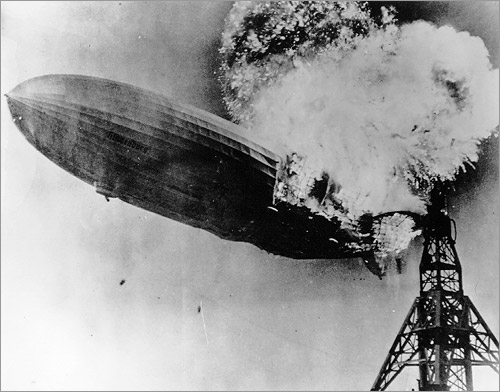May 6, 1937: Hindenburg explodes in New Jersey
May 6, 1937: A Ball of Fire und Alles Ist Kaput

- By Tony Long

- May 6, 2011 |
- 7:00 am |
- Categories: 20th century, Disasters, Transportation
1937: The German passenger zeppelin Hindenburg explodes and crashes while landing at Lakehurst, New Jersey, killing 36 people and dooming the future of commercial trans-Atlantic zeppelin service.
The Hindenburg (which might have been named Adolf Hitler if not for the strong anti-Nazi views held by Hugo Eckener, director of the Zeppelin Co.) and its sister ship, Graf Zeppelin II, are the largest aircraft ever to fly. They stretched 804 feet — nearly the length of the largest trans-Atlantic ocean liners of the period.
Although other nations, notably Great Britain and the United States, built rigid airships, the German technology was superior. The Hindenburg’s latticework airframe was constructed of a lightweight alloy composed largely of aluminum and copper. Sixteen gas cells expanded to a capacity of 7,062,100 cubic feet for lift, and the airship was propelled by four 16-cylinder diesel engines. it could carry 72 passengers and 60 crew across the Atlantic Ocean in just three days at a brisk 135 kilometers per hour [84 mph].
And it carried them in comfort. The passenger accommodations, contained in the airship’s hull rather than its gondola, were designed by Fritz August Breuhaus, who had done similar work with Pullman railroad coaches and ocean liners. Hindenburg at one point carried a grand piano on board, although this was later removed to save weight.
Hindenburg, designated LZ-129 by its builder and named for Field Marshal (and Weimar President) Paul von Hindenburg, was designed to be filled with nonflammable helium as the lifting agent. But the United States possessed all the planet’s natural helium sources, and imposed an embargo on selling the gas to Nazi Germany. The Zeppelin Co. turned to the far-more-combustible hydrogen.
The exact cause of the Lakehurst crash has never been established. Given the strained relationship that existed between Germany and the United States at the time, sabotage was an early and popular theory. It seems likelier, though, that a lightning strike, or sparking on the hull that ignited leaking hydrogen, was to blame.
Whatever the reason, the spectacular crash killed 35 of the 96 passengers and crew aboard, as well as one member of the ground crew. It also killed the trans-Atlantic zeppelin business.
The industry might have survived, at least until World War II, if not for the intense media coverage of the crash, highlighted by radio reporter Herbert Morrison’s anguished cry from the scene: “Oh, the humanity!”
Source: Various
Photo: The zeppelin Hindenburg catches fire May 6, 1937, at Lakehurst Naval Air Station, New Jersey. (Courtesy U.S. Navy)
This article first appeared on Wired.com May 6, 2008.